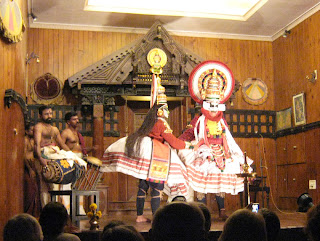On the way to my first Dravidian flute lesson I was hailed by the tailor whose hut, a corrugated iron-roofed structure with a view out over the Arabian Sea, was en route to the Juice Shack where I had first met Venugoptal. I had visited him the previous afternoon to choose material and have my flute measured for a bag. I had arranged to collect it later in the day but, although it would make me late, I responded to the tailor's enthusiasm in the only way I could. The bag wasn't quite finished so I watched the final stages and specified the length of the draw-string while the proprietor tried hard to persuade me to have some shirts made - a sure sign I had paid too much for the bag.
I hadn't haggled on this occasion for two reasons. Firstly, the man had refused to budge on the cost of a dress one of my daughters was keen on but didn't buy. And secondly, I had recently read the story of V.S. Naipaul and the cobbler in 'An Area of Darkness'.
The author had a pair of shoes in need of some stitching and took them to a cobbler in Bombay. He haggled aggressively over the cost of the repair and beat the man down to a very low price. The cobbler took one of the shoes, picked up a four inch nail and promptly drove it through the sole with a hammer. He only returned the shoe with a struggle. I wanted the tailor to make me a quality product.
 In the end the bag was certainly fit for purpose, although I think my presence distracted him and he let his machine get the better of him. There are a number of unnecessary black stitches near the mouth.
In the end the bag was certainly fit for purpose, although I think my presence distracted him and he let his machine get the better of him. There are a number of unnecessary black stitches near the mouth.
When I explained the delay to my teacher, the first thing he asked was the price I had paid for the bag.
"One hundred and eighty rupees," I said. (About £2.25 sterling)
"Ah," he replied. "You should not have paid more than a hundred rupees for a bag like this."
I immediately thought about the sum I had paid him for the flute.
However, he assured me the bag was a good idea, and not for the reasons I had supposed. Apparently he had twice been bitten on the lips by insects that had crawled into the warm, damp, dark space inside his flute. The creatures had taken exception when he put the instrument to his lips to blow and inflicted an injury that made it impossible to play for a couple of days, such was the swelling of his lip. This is not a problem I have ever experienced in the UK.
And then we went up the rickety stairs to the covered part of the juice bar and got down to musical business.
I hadn't haggled on this occasion for two reasons. Firstly, the man had refused to budge on the cost of a dress one of my daughters was keen on but didn't buy. And secondly, I had recently read the story of V.S. Naipaul and the cobbler in 'An Area of Darkness'.
The author had a pair of shoes in need of some stitching and took them to a cobbler in Bombay. He haggled aggressively over the cost of the repair and beat the man down to a very low price. The cobbler took one of the shoes, picked up a four inch nail and promptly drove it through the sole with a hammer. He only returned the shoe with a struggle. I wanted the tailor to make me a quality product.
 In the end the bag was certainly fit for purpose, although I think my presence distracted him and he let his machine get the better of him. There are a number of unnecessary black stitches near the mouth.
In the end the bag was certainly fit for purpose, although I think my presence distracted him and he let his machine get the better of him. There are a number of unnecessary black stitches near the mouth.When I explained the delay to my teacher, the first thing he asked was the price I had paid for the bag.
"One hundred and eighty rupees," I said. (About £2.25 sterling)
"Ah," he replied. "You should not have paid more than a hundred rupees for a bag like this."
I immediately thought about the sum I had paid him for the flute.
However, he assured me the bag was a good idea, and not for the reasons I had supposed. Apparently he had twice been bitten on the lips by insects that had crawled into the warm, damp, dark space inside his flute. The creatures had taken exception when he put the instrument to his lips to blow and inflicted an injury that made it impossible to play for a couple of days, such was the swelling of his lip. This is not a problem I have ever experienced in the UK.
And then we went up the rickety stairs to the covered part of the juice bar and got down to musical business.




























